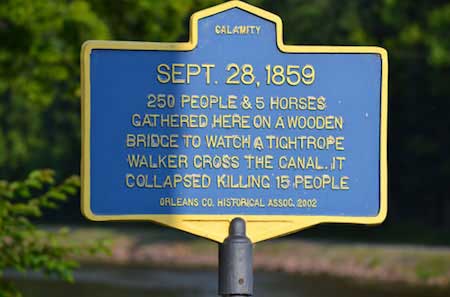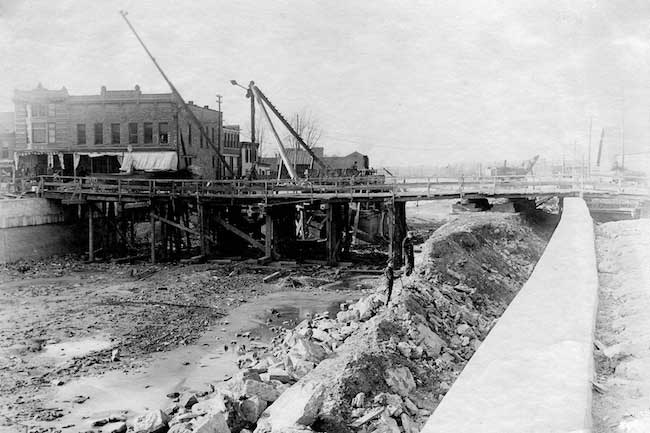Main Street Bridge in Albion was site of catastrophic collapse in 1859
“Overlooked Orleans” – Volume 3, Issue 31
The long, illustrious history of the Erie Canal is filled with tragedy and catastrophe despite its successes as an economic driving force for New York State. It seems fitting to recall one of the most frequently told stories relating to the Canal in Albion to close out this month.
On September 28, 1859, the residents of Orleans County were celebrating the opening day of the fair in Albion with a series of festivities. Conforming to popular fads of the time, a young gentleman was scheduled to walk a tight-rope stretched across the Erie Canal several rods west of the Main Street bridge. In the afternoon of Wednesday the 28th, the rope was strung from the second floor of the Mansion House south towards the second floor of Pierpont Dyer’s building.
The Blondin-esque feat attracted a massive crowd from across Orleans County as men, women, and children packed onto the three-arched iron bridge spanning across the water. The mob of people swarmed the west sidewalk on the bridge, hoping to catch a glimpse of the brave man. Witnesses recalled that there was little room to move; a team of horses pulling a lumber wagon driven by Samuel Smith had stopped along the southbound pathway of the bridge to see the spectacle that was set to begin relatively soon.
At 5:15 p.m., the man stepped out of the Mansion House’s second story window and began his slow journey across the Canal. It was not soon after that the bridge began to groan and scrape under the weight of the massive crowd assembled atop it. Within a matter of moments the western side of the bridge gave way, dumping throngs of bodies into the water. Those who were physically able to swam to shore where they were pulled from the water by onlookers. Others found themselves trapped under the debris, dragged underwater by soaked clothing. Amos Clift of Gaines recalled thrashing about helplessly as his coat held him in place underwater. After a few moments of struggling he was able to free himself and swim ashore.
John Leonard, a local resident at the time, later recalled seeing a woman wandering about screaming, “Oh, I have lost my baby, I have lost my baby.” Panic-stricken, she failed to realize that the child was stuck under her arm, the head sticking out one way and the legs out the other. Leonard humorously recalled the child’s grin as it lapped up the water running down its face. Others were not as lucky, as newspapers reported fifteen fatalities as a result of the catastrophe. Five horses were visible on the bridge when it collapsed and some speculated that the animals, which thrashed and floundered about in the water, may have contributed to the deaths of some and injuries of others.
Dr. McKennan summoned a coroner’s jury comprised of Noah Davis, Dr. Lemuel Paine, Benjamin Bessac, Volkert Bullock, Harvey Goodrich, Hiram Goff, John Hull White, and Lewis Warner to investigate the calamity. Naturally, the deaths were attributed to drowning, but the jury criticized the condition of the bridge and condemned the “fool-hardy business of rope-walking.” In the following days, the papers printed the names of the local individuals who died as a result of the collapse; Adelbert Wilcox, Thomas Cady, Edwin Stilson, Mary Jane Lavery, Sarah Thomas, Caroline Augusta Martyn, William Henry, Ransom Murdock, Anna Veile, Charles Roosevelt, Thomas Handy, Sophia Pratt, Perry Cole, Lydia Harris, and the young son of Peter Cornell.
This bridge was subsequently repaired and the iconic swing bridge was later installed in 1871. Although the swing bridge faithfully served boat traffic along the Canal, the Superintendent of the Canal recommended as early as 1885 that the bridge be replaced with a lift apparatus to increase traffic and efficiency between Buffalo and Rochester.
This photograph was taken on December 10, 1912 and shows the replacement of the old swing bridge. In early November of 1912, the W. S. Cooper Barge Canal Construction Company began the process of removing the swing bridge in preparation to install the current lift bridge. While moving the bridge to the east for installation as a temporary crossing, the bridge split in two.

Photo by Tom Rivers: This historic marker acknowledges a horrific day in Albion’s history.
The lack of a temporary pathway across the Canal forced residents to travel as far as Gaines Basin to visit the northern end of Albion; the Ingersoll Lift Bridge was under construction at the time. Dye Hose Fire Chief C. Royce Sawyer reminded state officials that without a bridge, fire apparatus were unable to reach the north end of the village, forcing local fire companies to carry hose across the Canal in the case of a catastrophic fire.
Visible in the forefront of this image is the temporary bridge constructed by W. S. Cooper after the destruction of the swing bridge. During this time, the Canal was also expanded to its current width of 120 feet and depth of 12 feet. A NYS Historic Marker situated on the south side of the canal commemorates the location of this devastating accident.






































































